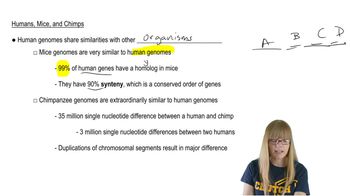Table of contents
- 1. Introduction to Genetics51m
- 2. Mendel's Laws of Inheritance3h 37m
- 3. Extensions to Mendelian Inheritance2h 41m
- 4. Genetic Mapping and Linkage2h 28m
- 5. Genetics of Bacteria and Viruses1h 21m
- 6. Chromosomal Variation1h 48m
- 7. DNA and Chromosome Structure56m
- 8. DNA Replication1h 10m
- 9. Mitosis and Meiosis1h 34m
- 10. Transcription1h 0m
- 11. Translation58m
- 12. Gene Regulation in Prokaryotes1h 19m
- 13. Gene Regulation in Eukaryotes44m
- 14. Genetic Control of Development44m
- 15. Genomes and Genomics1h 50m
- 16. Transposable Elements47m
- 17. Mutation, Repair, and Recombination1h 6m
- 18. Molecular Genetic Tools19m
- 19. Cancer Genetics29m
- 20. Quantitative Genetics1h 26m
- 21. Population Genetics50m
- 22. Evolutionary Genetics29m
4. Genetic Mapping and Linkage
Mapping Genes
Problem 2b
Textbook Question
In a diploid species of plant, the genes for plant height and fruit shape are syntenic and separated by 18 m.u. Allele D produces tall plants and is dominant to d for short plants, and allele R produces round fruit and is dominant to r for oval fruit.
Give the same information for a plant with the genotype Dr/dR.
 Verified step by step guidance
Verified step by step guidance1
Understand the problem: The question involves a diploid plant species with two syntenic genes (genes located on the same chromosome). The genes are separated by 18 map units (m.u.), which indicates a 18% recombination frequency. The alleles D and d control plant height, while R and r control fruit shape. The genotype Dr/dR represents the arrangement of alleles on homologous chromosomes.
Interpret the genotype Dr/dR: This notation indicates that one homologous chromosome carries the D allele for tall plants and the r allele for oval fruit, while the other homologous chromosome carries the d allele for short plants and the R allele for round fruit. This arrangement is referred to as a 'repulsion' or 'trans' configuration because the dominant alleles (D and R) are on different chromosomes.
Determine the parental and recombinant gametes: Since the genes are syntenic and separated by 18 m.u., the parental gametes (Dr and dR) will be more frequent, while the recombinant gametes (DR and dr) will occur less frequently. The recombination frequency of 18% means that 18% of the gametes will be recombinant, and the remaining 82% will be parental.
Calculate the expected proportions of gametes: To determine the proportions of each type of gamete, divide the recombination frequency equally between the two recombinant gametes (DR and dr). Similarly, divide the remaining frequency equally between the two parental gametes (Dr and dR). For example, if 18% are recombinant, then 9% will be DR and 9% will be dr, while 41% will be Dr and 41% will be dR.
Summarize the information: The plant with the genotype Dr/dR will produce four types of gametes: Dr, dR, DR, and dr. The parental gametes (Dr and dR) will be more frequent, while the recombinant gametes (DR and dr) will be less frequent. The exact proportions depend on the recombination frequency of 18%.
 Verified video answer for a similar problem:
Verified video answer for a similar problem:This video solution was recommended by our tutors as helpful for the problem above
Video duration:
4mPlay a video:
Was this helpful?
Key Concepts
Here are the essential concepts you must grasp in order to answer the question correctly.
Synteny
Synteny refers to the conservation of gene order on chromosomes across different species or within a species. In this context, it indicates that the genes for plant height and fruit shape are located on the same chromosome and maintain their relative positions, which can affect inheritance patterns and genetic linkage.
Recommended video:
Guided course

Humans, Mice, and Chimps
Genotype and Alleles
A genotype is the genetic constitution of an organism, represented by the alleles it possesses for specific traits. In the given example, 'Dr/dR' indicates that the plant has one allele for tall plants (D) and one for short plants (d), as well as one allele for round fruit (R) and one for oval fruit (r), showcasing the concept of heterozygosity.
Recommended video:
Guided course

New Alleles and Migration
Map Units (m.u.)
Map units (m.u.) are a unit of measurement used in genetics to express the distance between genes on a chromosome, based on the frequency of recombination during meiosis. An 18 m.u. separation suggests that there is an 18% chance of recombination occurring between the genes for height and fruit shape, which influences the inheritance patterns of these traits.
Recommended video:
Guided course

Mapping Genes
Related Videos
Related Practice
Multiple Choice
Given a group of asci from a cross between two genes, what does a recombination frequency of 20% indicate about the distance between the two genes?
22
views


